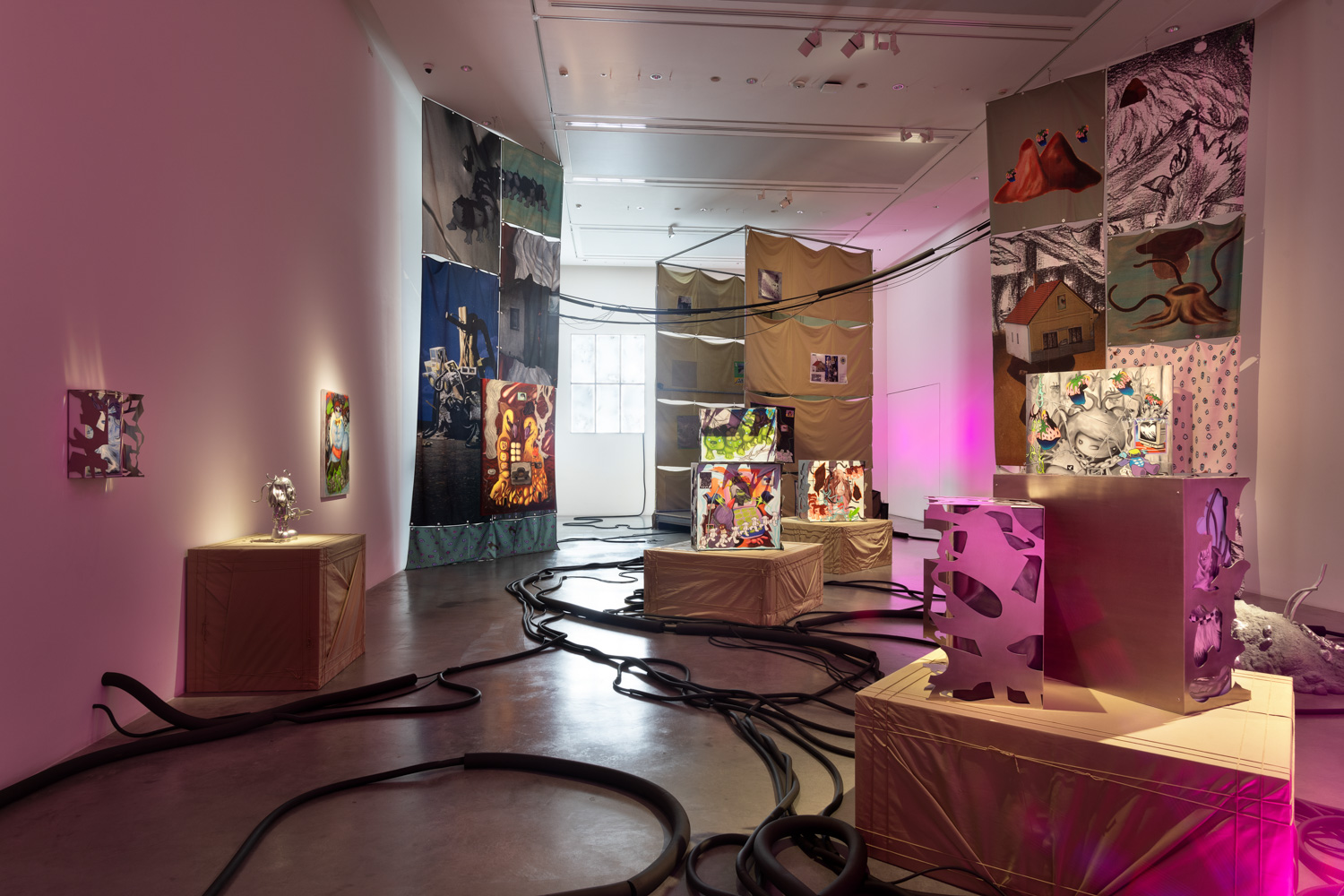
PASSCODE, THE DARK DAY
CHANIDA VORAPHITAK, AN ARTIST WHO CREATED THE ‘KA-FAI ANGLES’ DISCLOSES HER PROCESSES OF EACH WORK AND EXHIBITION, ESPECIALLY THE ROLES OF TECHNOLOGY FOR CREATIVITIES
TEXT: CHIWIN LAOKETKIT
PHOTO COURTESY OF THE ARTIST AND BANGKOK CITYCITY GALLERY
(For Thai, press here)
Many design aficionados might already recognize the distinctive charm of the ‘Cuscus the Cuckoos’ brand, celebrated for its vivid depictions of animal characters in dynamic graphics and bold colors, with Chanida ‘Kook’ Voraphitak as the creative force behind it all. On an afternoon at BANGKOK CITYCITY GALLERY, art4d had the opportunity to sit down with Voraphitak to discuss her use of technology in design, as well as the ideas behind her efforts to connect with audiences through the whimsical stories of the Ka-Fai Angles. This mythical ensemble of angels and demons navigates a world marked by scientific discovery and environmental challenges—themes recently explored in her recent exhibition, PASSCODE, THE DARK DAY.
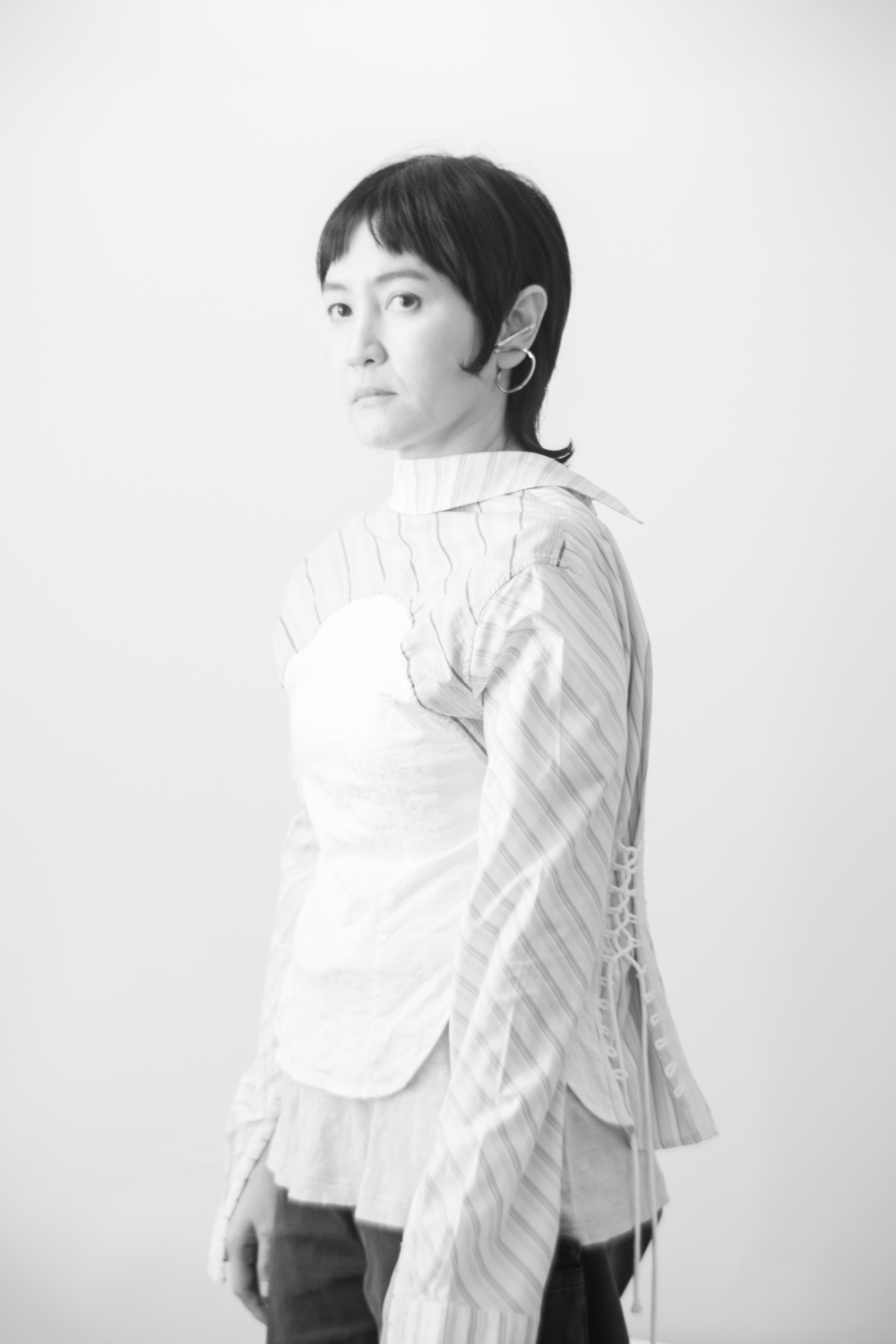
Chanida Voraphitak | Photo: Akkarawin Krairiksh
art4d: How did you come to exhibit at the BANGKOK CITYCITY GALLERY?
Chanida Voraphitak: I was relatively new to organizing exhibitions and initially unsure about which direction I should take my work. When the BANGKOK CITYCITY GALLERY asked me to exhibit PASSCODE, THE DARK DAY at their space, I accepted the invitation immediately. I remember feeling super happy the first day before it became a mix of pressure and excitement as a flood of ideas came rushing in. I worked to collect and define the ideas, and together began planning the exhibition with my team, learning immensely throughout the nearly year-long process.
Organizing an exhibition is a discipline in its own right. For the intricate lighting design, I collaborated with specialists like Rueangrith ‘Ton Yai’ Suntisuk and Pornpan ‘Ching’ Arayaveerasid from DuckUnit. The auditory aspect featured ambient construction noises, a creative touch from Pansan ‘Kan’ Klongdee and Voranat ‘Erk’ Voraphitak. As my husband and I regularly host a music event called ShapeShifter, we understand the importance of balancing audio with visual elements. The visuals were envisioned to be dynamic from the outset, incorporating animated images to bring the exhibition to life.

art4d: What is the meaning behind the title PASSCODE, THE DARK DAY?
CV: The titles signify the connection from one thing to another, much like wanting a dog or seeking a partner requires you to break down certain barriers. It took me quite a while to finalize the title because the exhibition evolved from stories I had written and topics I am passionate about, before ultimately developing into something much larger. I worked on the exhibition first and named it only at the very end. Some describe it as loud but good, others as cute and playful. Each person perceives it differently. During the creative process, I didn’t set any boundaries, making the work universally accessible rather than targeted. The VR aspect developed from graphics, which were derived from about 20 different conceptual phrases. My main aim for the work was to embody a sense of freedom.
As for Cable Boii, the idea was envisioned as an angel blended with a unique creature featuring mutant electrical wires, which is an attempt to appeal to fans of 1990s comics. During the exhibition, I noticed that there were children and foreigners, westerners to be specific, who were drawn in by the piece. I found that children could engage with the VR much longer than adults, which was quite insightful.
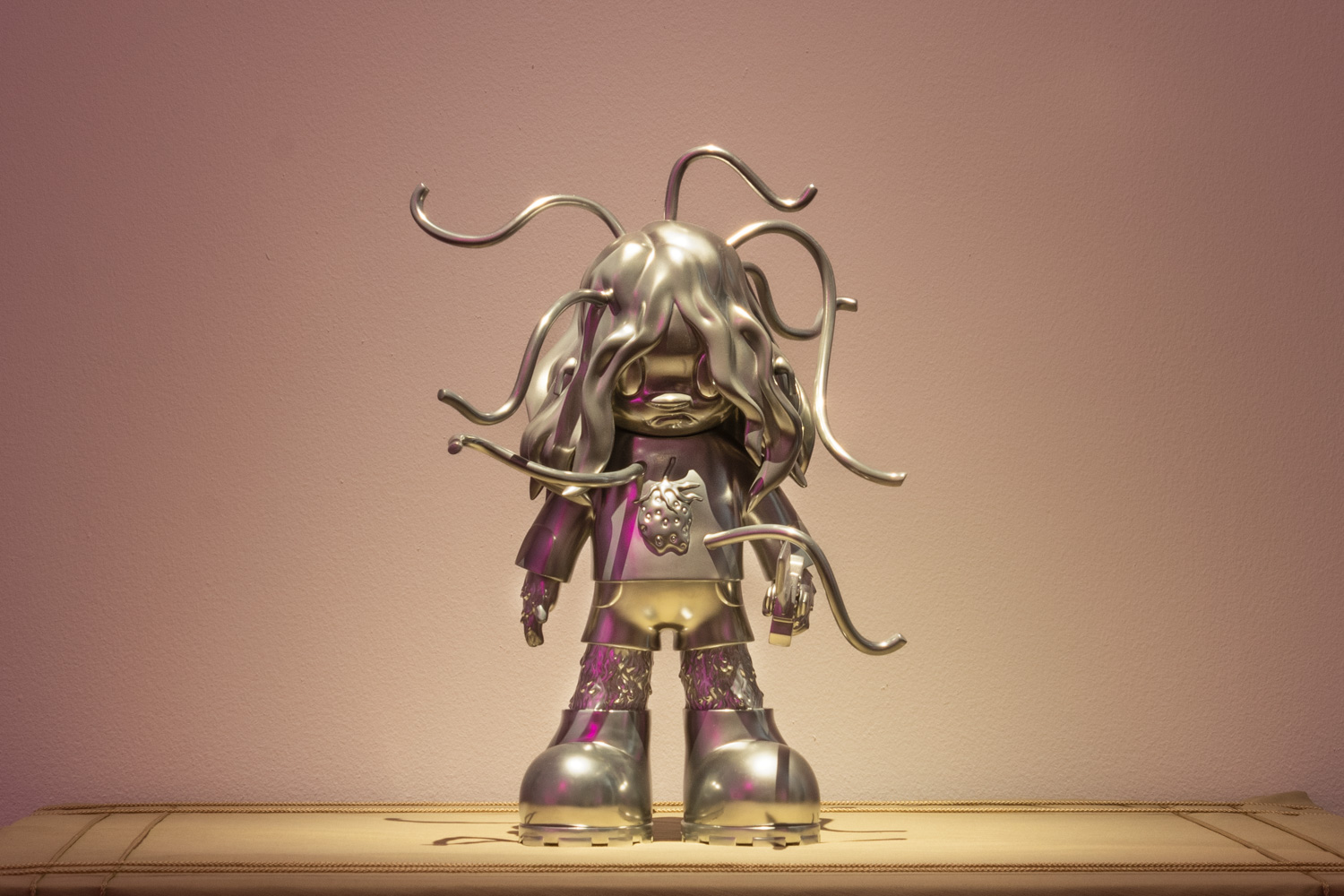
Cable Boii
art4d: Do you have a favorite ’90s cartoon?
CV: Absolutely, ‘Courage the Cowardly Dog’ is my favorite. It’s about this dog who lives with his elderly owners, and every morning, he would wake up to a bizarre scenario where he turns into a zombie. He has to figure out how to alert his owners about what’s happening. Each episode features a different storyline. Sometimes they would encounter a thief or find themselves in various scenarios. Interestingly, the purple sky in our VR was inspired by the show’s distinct style.
Growing up in the ’90s and early 2000s, I was really drawn to movies, cartoons, and books that delved into futuristic themes—apocalypses, robots, you name it. Osamu Tezuka’s creations, like ‘Phoenix’, and ‘Dororo’, really struck a chord with me. They were steeped in post-war sentiments and packed with advanced sci-fi elements. Some of the episodes were quite somber and melancholic, dealing with themes of death and rebirth. I would spend hours lost in these stories. And now, witnessing the rise of innovations like Elon Musk’s Neuralink brain chip implants, which aren’t just about helping someone speak another language, say Chinese, instantly, but could potentially improve how efficiently the brains of people with paralysis function. It’s like watching the concepts from those old sci-fi movies slowly become our reality

art4d: It seems that in VR, you explore the issue of technology overload and raise questions about the environment as well.
CV: I don’t provide definitive answers about what it is exactly; I want to give viewers the opportunity to wonder and ponder about why trees are entwined around them. The environmental aspect is also significant for me. Recently, there was construction near my home, which made me curious about where the cement came from, how the wires were made, and what creates dust. I began wondering about why the dust doesn’t just disappear, so I started researching.
For example, why do people living near mines develop cancer, or how is coal used to generate electricity in rural provinces and then transmitted to Bangkok? This led me to create a work titled ‘Phone Charger.’ It stemmed from me thinking about lithium, a component in battery chargers, and imagining how changing a single iPhone affects the environment. I included smoke as an element, adding the element of fantasy to it, making it feel more like a monster, because in a scientific sense, these minerals are actually alive.
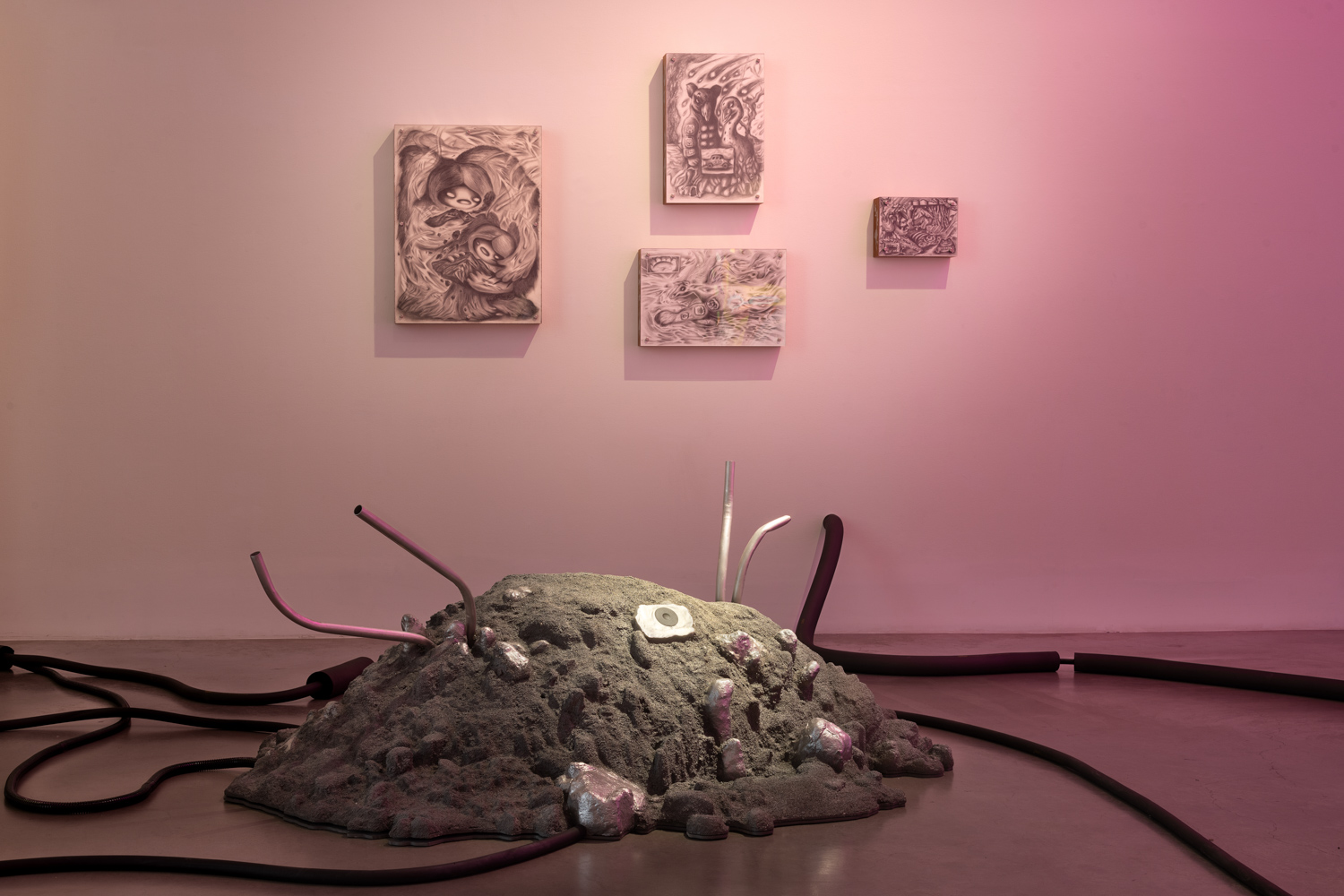
Phone Charger
art4d: What does the monster represent in your perspective?
CV: To me, a monster is a character that embodies enormity; something larger-than-life that is evil, yet has an intriguing backstory. I prefer these characters over traditional heroes or heroines. In my work, there are hardly any humans; it’s more about objects, spirits, or beings like bears or monsters. I don’t want people to favor one creature over another. Even in some drawings, I’m not sure if the creature is a bear, a frog, or something else entirely. I want these beings to have their unique mystique, depending on how the piece is arranged.
Ka-Fai Angles are monsters, and I categorize them as angels who can be good or evil, depending on their characters and personalities. But the creature I love the most would be bears. You can’t own bears. I’m particularly fond of grizzly bears that eat salmon, and I also love collecting vintage bear toys. Visiting a designer toy market is like entering another world; each toy has the signature of its brand, with varying eye placements and sizes. Now, I make a decision based on which one I feel a connection with, and it’s a subject I gradually explore and learn more about.
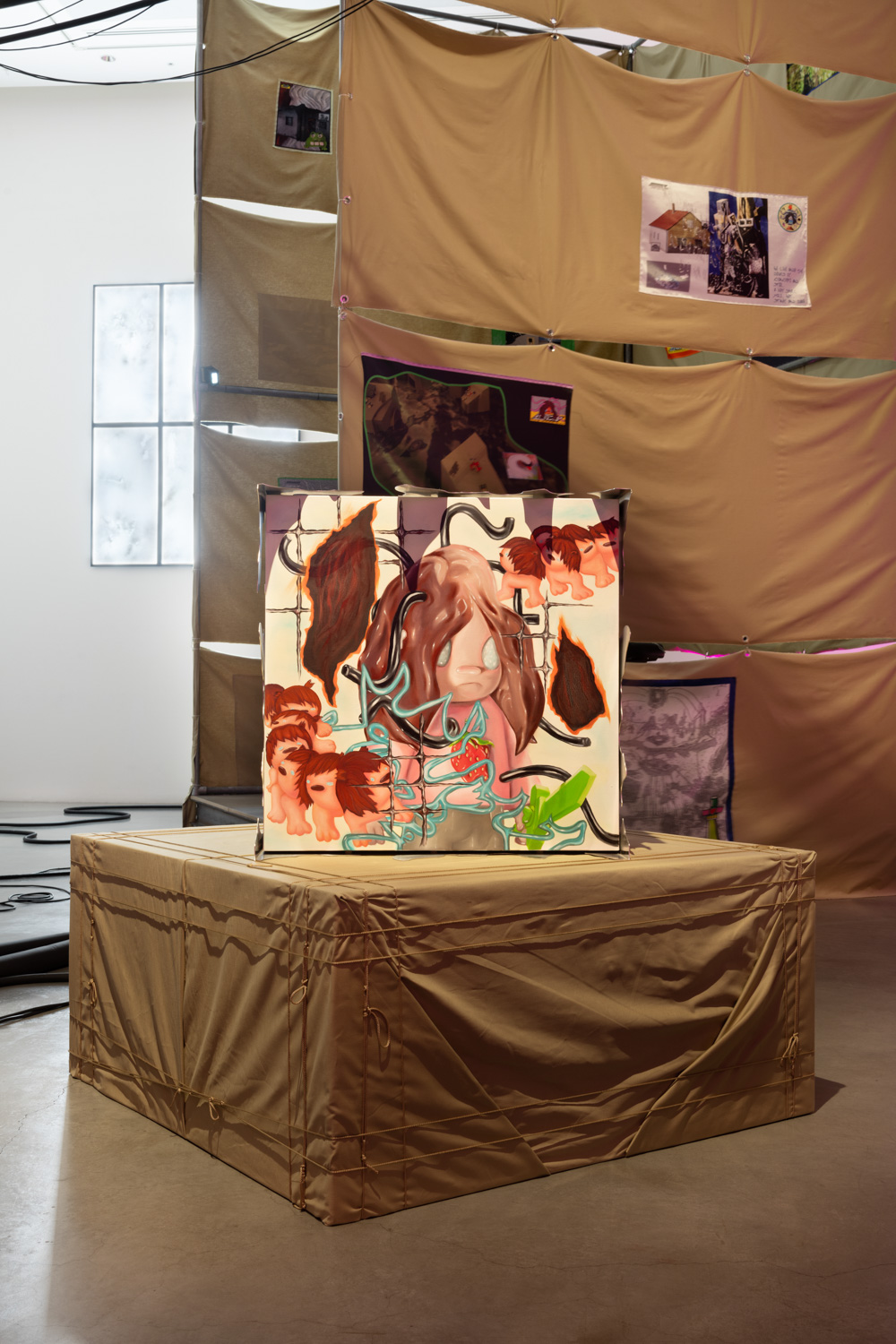
art4d: We’ve heard you have pets. How do you plan your workday in the studio with them around?
CV: Yes, I have dogs, cats, and some exotic animals. Just feeding them can take up a whole day, you know. But that doesn’t mean the house is overwhelmed with animals, though; they each have their own zones. I work in my own studio and my day mostly starts with breakfast and coffee, followed by a meeting with my team, who is also my husband since we share the studio. I would usually get into full work mode by mid-morning. I try to keep to a schedule, starting at 10 AM and wrapping up by 7:30 PM. My day involves sketching, exploring color palettes—sometimes using very little to no red, other times using a lot of red, and occasionally adding flowers if there are none.
When I work, I refrain from looking at other people’s work because the images can get stuck in my mind. I also play all kinds of music to stay alert and awake. The last six months before an exhibition are the busiest, and I hardly check or know what’s happening on social media during this time.

Chanida Voraphitak Studio | Photo: Akkarawin Krairiksh
art4d: Have you ever worked with AI, and how do you feel about works that people say infringe on copyrights?
CV: I’ve used GANs (Generative Adversarial Networks) to help with the photography of my work. After a while, the data begins to duplicate unless I train it to adapt to my style. Technology has advanced greatly now and you can make movies and videos with it. It does allow us to see what inanimate things can come up with and this type of work does have its own charm, from a computer’s perspective.
About copyright infringement, certainly, it’s not okay to breach someone else’s rights. There must be boundaries, but it’s something we all need to keep an eye on. Even conceptual artists and painters have used AI to sketch out their initial concepts. Institutions like the MoMA (Museum of Modern Art in New York) have embraced AI art, which likely means more people will use AI in their work. I’ve seen people using AI before developing the generated works into actual paintings, and I’ve always liked paintings. Nevertheless, to me, using AI can be a bit overwhelming—it’s challenging enough to bring out all the ideas I have in my head, you know.
art4d: After the PASSCODE, THE DARK DAY exhibition, what projects are you interested in pursuing next?
CV: I’d like to create a comic book, but I’m hesitant to set up the final plot. Someone suggested making it like a Marvel Universe movie where the characters are interconnected. I think if it were a film, I’d want it to be in 3D. I like characters in a VR world that blends gaming and cinema. Many new games are like that, featuring more narrative scenes than gameplay.
Currently, I’ve opened a space called ‘Liquid Metal.’ We have books for everyone to read and serve drinks and homemade yogurt, similar to a coffee shop. We’ve created and prepared this space to host music festivals featuring foreign artists and their design projects and films. It would be a shame if they only performed for one night at a pub and then left. We aim to have full-scale speakers like those used in club scenes. During the day, we’re thinking about inviting someone to collaborate on projects like VR or host a film festival that fits our style. Although it’s relatively still just a small space now, we envision it expanding in the future.
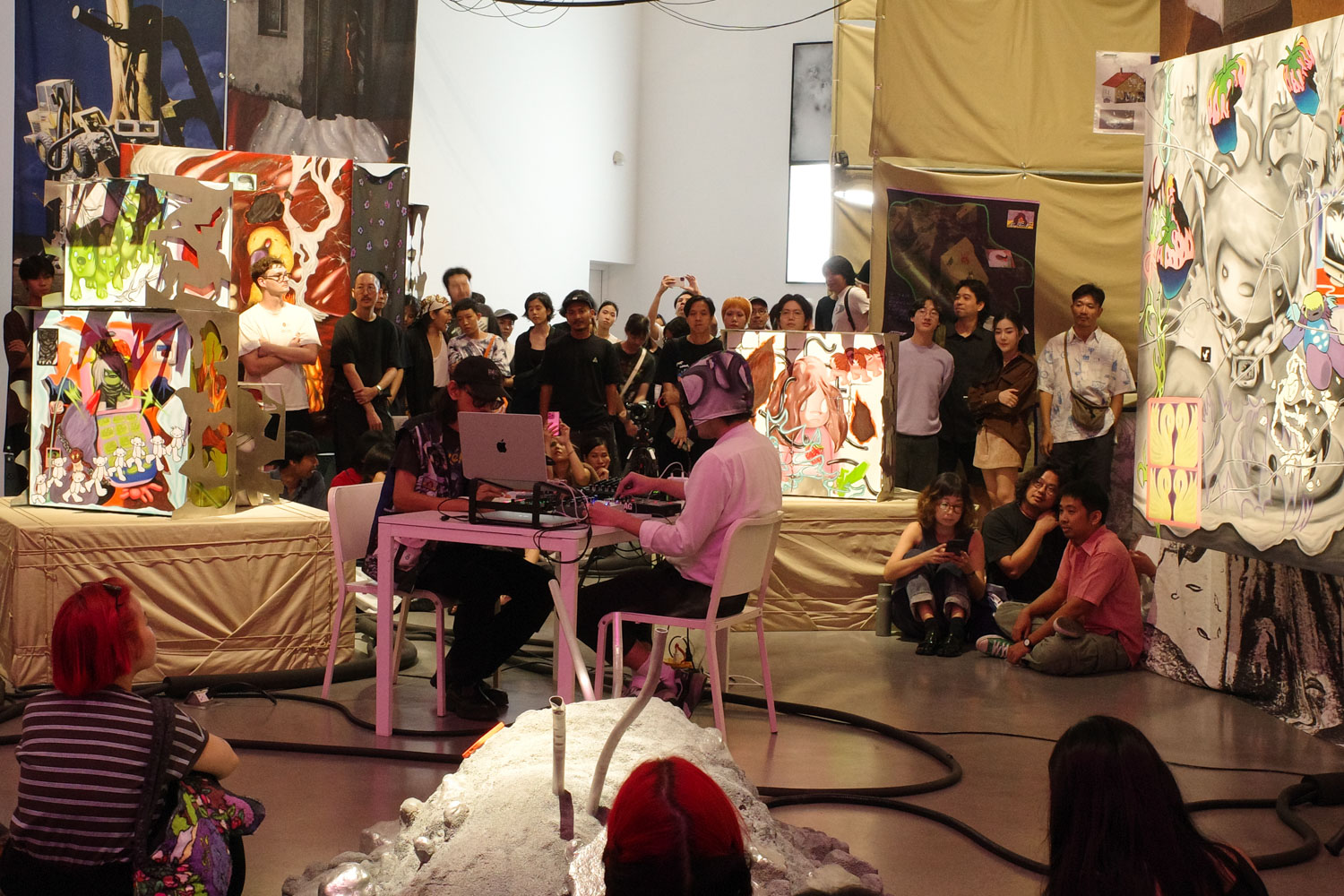
Opening Reception Day | Photo: Woratach Paiboon
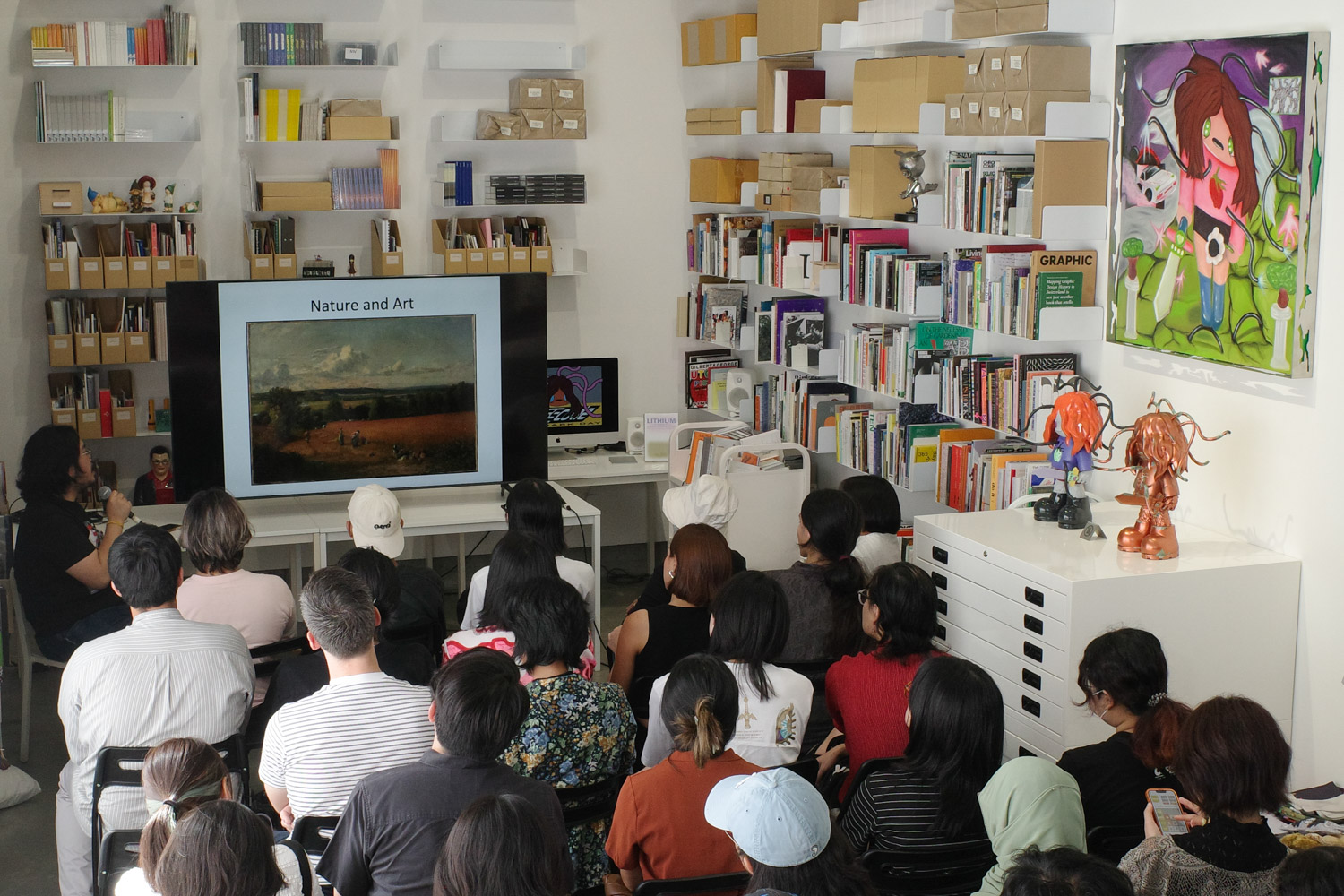
Public Program | Photo: Woratach Paiboon

